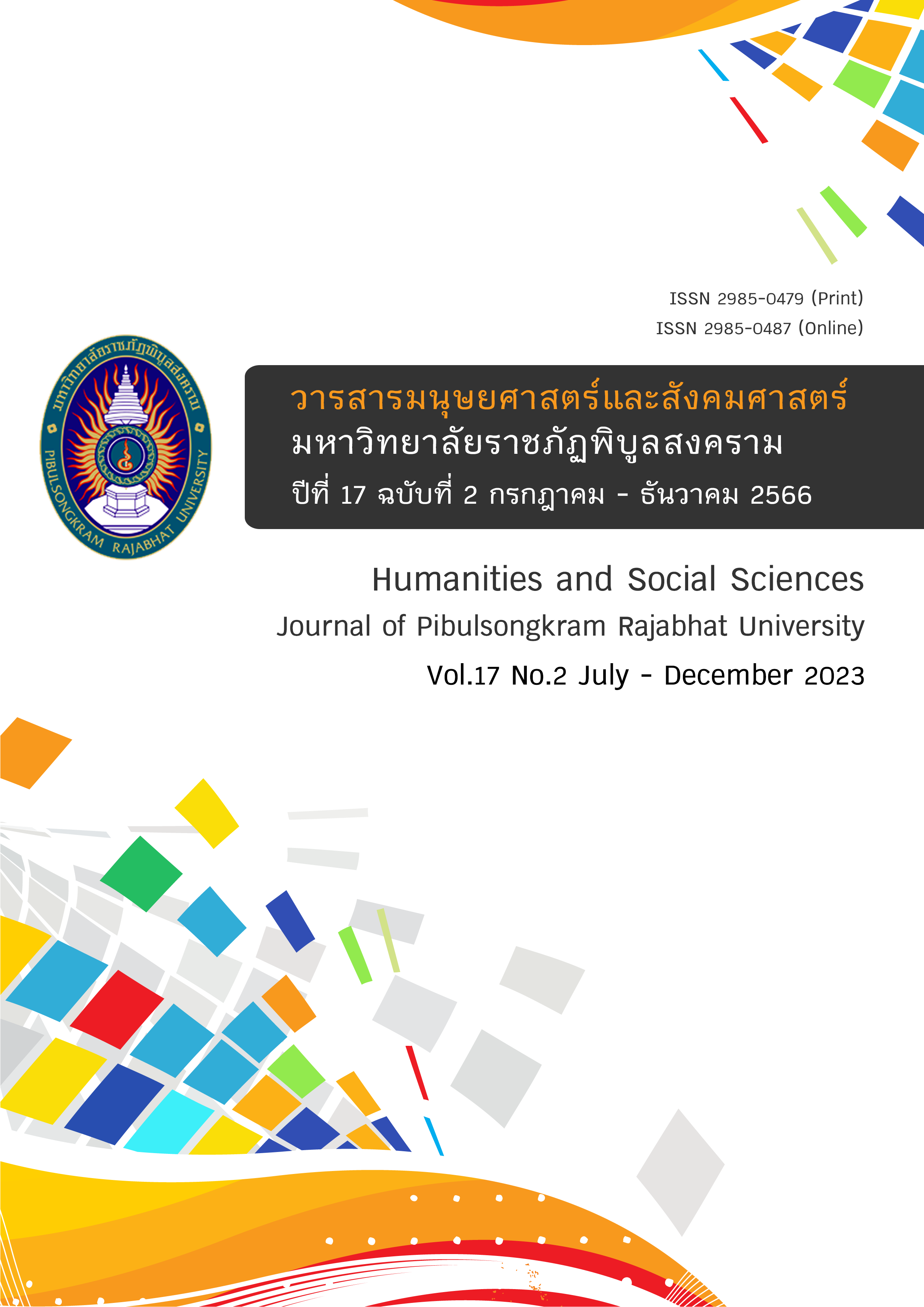Guideline for the Development of Online Teaching and Learning Management to Meet the Demands of Students at Faculty of Management Science Bansomdejchaopraya Rajabhat University by Using the Kano Model
DOI:
https://doi.org/10.14456/psruhss.2023.52Keywords:
Online teaching and learning, Learning management, Kano modelAbstract
This research uses the Kano model to study the characteristics of online teaching and learning management and ways to develop online teaching and learning management to meet the demands of students. The sample group consisted of 334 students from Bansomdetchaopraya Rajabhat University's Faculty of Management Science. The tool used is a questionnaire on student needs, which contains 19 characteristics, both positive and negative, and the questionnaire data were analyzed using the Kano model to find the coefficient of satisfaction of students with online teaching and learning management. The survey and data analysis using the Kano model revealed that they were able to classify characteristics that affect the level of preference and impression of students. It can be divided into 2 groups: 1) attractive attributes that influence the impression or attraction of online learning, such as a teacher's having already prepared and compiled the study material, and 2) necessary characteristics (expected features or must-haves) that affect satisfaction in online learning, consisting of: such as the university's supporting the tools for online learning, earning points accumulated from work, a teacher's readiness to teach online, and students' readiness to study online.
References
เขมณัฏฐ์ มิ่งศิริธรรม. (2559). การออกแบบสื่อการศึกษาสร้างสรรค์ (Creative education media design). กรุงเทพฯ: จุฬาลงกรณ์มหาวิทยาลัย.
ชนินทร์ ตั้งพานทอง. (2560). ปัจจัยที่มีต่อผลสัมฤทธิ์ทางการเรียนออนไลน์เพื่อเสริมการเรียนการสอน (วิทยานิพนธ์วิทยาศาสตรมหาบัณฑิต). กรุงเทพฯ: จุฬาลงกรณ์มหาวิทยาลัย.
ชาลิสา จิตบุญญาพนิจ. (2559). ผลการเรียนรู้และผลสัมฤทธิ์ทางการศึกษาในการพัฒนารูปแบบการเรียนการสอนโดยใช้ บทเรียนอีเลิร์นนิ่งในรายวิชาเทคโนโลยีสารสนเทศ สำหรับนักเรียนมัธยมศึกษาปีที่ 1. ใน การประชุมวิชาการระดับชาติและนานาชาติ มหาวิทยาลัยศรีปทุม ครั้งที่ 11 . กรุงเทพฯ: มหาวิทยาลัยศรีปทุม.
ฐาปนีย์ ธรรมเมธา. (2557). อีเลิร์นนิง: จากทฤษฎีสู่การปฏิบัติ e-Learning: from theory to practice. กรุงเทพฯ: โครงการมหาวิทยาลัยไซเบอร์ไทย สำนักงานคณะกรรมการการอุดมศึกษา.
เดชา นานอก, และนัฎฐวิกา จันทร์ศรี. (2558). การประยุกต์ใช้แบบจำลองคาโนในกิจกรรมนำเสนอชิ้นส่วนเครื่องจักรกลอัตโนมัติ. ใน การประชุมทางวิชาการของมหาวิทยาลัยเกษตรศาสตร์ ครั้งที่ 53 (น. 408-409). กรุงเทพฯ: มหาวิทยาลัยเกษตรศาสตร์.
ทรงศักดิ์ ภูสีอ่อน. (2551). การประยุกต์ใช้ SPSS วิเคราะห์ข้อมูลงานวิจัย. กาฬสินธุ์: ประสานการพิมพ์.
ธนพรรณ ทรัพย์ธนาดล. (2554). ปัจจัยที่มีผลกระทบต่อการจัดการเรียนการสอนบทเรียนออนไลน์ของมหาวิทยาลัยราชภัฏนครราชสีมา. Veridian E-Journal SU, 4(1), 652-666.
ธนัชชา บินดุเหล็ม. (2562). ผลของการสอนแบบออนไลน์ที่มีต่อผลสัมฤทธิ์ทางการเรียนของนักเรียนระดับประกาศนียบัตรวิชาชีพชั้นสูงปีที่ 1. ใน การประชุมหาดใหญ่วิชาการระดับชาติและนานาชาติ ครั้งที่ 10. สงขลา: มหาวิทยาลัยหาดใหญ่.
ธัญนันท์ ใจปัน, และจักรกฤษณ์ พจนศิลป์. (2559). การวิเคราะห์คุณลักษณะที่เหมาะสมของผลิตภัณฑ์ น้ำมะเขือเทศสำหรับผู้บริโภคในเขตกรุงเทพมหานคร. วารสารเศรษฐศาสตร์รามคำแหง, 2(1), 53-76.
ปริญญ์ บุญกนิษฐ์, และอรรคเจตต์ อภิขจรศิลป์. (2552). การออกแบบผลิตภัณฑ์อุตสาหกรรม. กรุงเทพ: ฝ่ายสารสนเทศและวิชาการ สถาบันไฟฟ้าและอิเล็กทรอนิกส์.
แพรวกมล ชาปะวัง, และวรรณี แกมเกตุ. (2557). การวิเคราะห์ความพึงพอใจของนิสิตนักศึกษาที่มีต่อลักษณะการให้คำปรึกษา ของอาจารย์ที่ปรึกษาวิทยานิพนธ์โดยประยุกต์ใช้โมเดลคาโน. วารสารอิเล็กทรอนิกส์ทางการศึกษา, 9(2), 699-709.
มหาวิทยาลัยราชภัฏบ้านสมเด็จเจ้าพระยา. (2563). จํานวนนักศึกษาลงทะเบียนเรียน ภาคเรียนที่ 1 ปีการศึกษา 2563 ภาพรวมทุกระดับ จําแนกตามคณะ. สืบค้น 14 มีนาคม 2564, จาก https://1th.me/I6tyl
มหาวิทยาลัยราชภัฏบ้านสมเด็จเจ้าพระยา. (2564). ประกาศมหาวิทยาลัยราชภัฏบ้านสมเด็จเจ้าพระยา เรื่อง แนวทางการจัดการเรียนการสอน อันเนื่องมาจากการแพร่ระบาดของเชื้อไวร้สโคโรนา 2019 ฉบับที่ 4. สืบค้น 14 มีนาคม 2564, จาก https://1th.me/bfuCc
รัฐนันท์ พงศ์วิริทธิ์ธร, เบญญาภา กันทะวงศ์วาร, รุจิรา สุขมณี, และชัชวิน วรปรีชา. (2558). แนวทางการพัฒนาส่วนประสมทางการตลาดโครงการหลวงหนองหอยเพื่อการท่องเที่ยวเชิงเกษตรอย่างยั่งยืน โดยประยุกต์ใช้การวิเคราะห์คาโนโมเดล. วารสารเทคโนโลยีสุรนารี, 7(1), 17-35.
วราภรณ์ จึงสุวดี. (2553). การประยุกต์เทคนิคการกระจายหน้าที่การทำงานเชิงคุณภาพ เพื่อการวางแผนปรับปรุงคุณภาพการบริหาร โรงเรียนเศรษฐเสถียร ในพระราชูปถัมภ์ (ปริญญานิพนธ์การบริหารการศึกษามหาบัณฑิต) กรุงเทพฯ: มหาวิทยาลัยศรีนครินทรวิโรฒ.
สมเกียรติ จันทร์เทศ, ธงชัย สุวรรณสิชณน์ และสุนทรี สุวรรณสิชณน์. (2556). การประยุกต์แบบจำลองคาโนค้นหาความต้องการของผู้บริโภคในผลิตภัณฑ์มะม่วงอัดเม็ด. ใน การประชุมทางวิชาการของมหาวิทยาลัยเกษตรศาสตร์ ครั้งที่ 51 (น. 347). กรุงเทพฯ: สำนักงานกองทุนสนับสนุนการวิจัย.
สุนีย์ ศิลพิพัฒน์, ศิริพร สัจจานันท์, ระวีวรรณ มาลัยวรรณ, วิไล วัฒนดำรงกิจ, และนวลเสน่ห์ วงศ์เชิดธรรม. (2550). การเรียนการสอนผ่านระบบอิเล็กทรอนิกส์ชุดวิชาเศรษฐศาสตร์ระหว่างประเทศโดยใช้ T5 Model (รายงานการวิจัย). กรุงเทพฯ: สถาบันวิจัยและพัฒนา มหาวิทยาลัยสุโขทัยธรรมาธิราช.
สุวัฒน์ บรรลือ. (2560). รูปแบบการจัดการเรียนการสอนออนไลน์ที่เหมาะสมสำหรับมหาวิทยาลัยราชภัฏอุบลราชธานี. วารสารมหาวิทยาลัยราชภัฏร้อยเอ็ด, 11(2), 250-260.
Aksorn. (2020). เมื่อเกิดความเปลี่ยนแปลงของโลกการศึกษาจากวิกฤติ โควิด-19 แล้วอนาคตทางการศึกษา จะเป็นอย่างไรต่อไป?. สืบค้น 14 มีนาคม 2564, จาก https://www.aksorn.com/learningviaonline
Berger, C., Blauth, R., Boger, D., Bolster, C., Burchill,G., DuMouchel, W., Pouliot, F., Richter, R., Rubinoff, A., Shen, D., Timko, & M., Walden. (1993). Kano’s Methods for Understanding Customer-defined Quality. Center for Quality Management Journal, 2(4), 2-36.
Chaudha, A., Jain, R., Singh, A. R., & Mishra, P. K. (2011). Integration of Kano’s Model into quality function deployment (QFD). The International Journal of Advanced Manufacturing Technology, 53, 689-698.
Kano, N, Takahashi, F., & Tsuji, S. (1984). Attractive quality and must be quality. The Japan Sociaty for Quality Control, 14(2), 39-48.
Krejcie, R. V., & Morgan, D. W. (1970). Determining Sample Size for Research Activities. Educational and Psychological Measurement, 30(3), 607-610.
Matthew, K.I. & Varagoor, G. (2001). Student Responses to Online Course Materials. Journal of Research on Computing in Education, 33(5), 1-20.
Nunnally, J. (1978). Psychometric theory. New York: McGraw Hill.
Salinas, Fidel Michael, Jr. (2001). Comparative learning methods of cognitive computerbased training with and without multimedia blending. In Digital Dissertation Abstracts International, 62(2), 540.
Xu, Q., Jiao, R. J., Yang, X., Helander, M., Khalid, H. M., & Opperud, A. (2009). An analytical Kano model for customer need analysis. Design studies, 30(1), 87-110.
Yeoh, Kok Cheow. (2002). A study on the influences of computer usage on idea formation in graphic design students. In Digital Dissertation Abstracts International. 63(10), 3402.
Zultner, R. E., & Mazur, G. H. (2006). The Kano Model: Recent Developments. The Eighteenth Symposium on Quality Function Deployment-Auatin, Texas, 109-116.
Downloads
Published
How to Cite
Issue
Section
License
Copyright (c) 2023 Humanities and Social Sciences Journal of Pibulsongkram Rajabhat University

This work is licensed under a Creative Commons Attribution-NonCommercial-NoDerivatives 4.0 International License.
Any articles or comments appearing in the Journal of Humanities and Social Sciences, Rajabhat Phibulsongkram University, are the intellectual property of the authors, and do not necessarily reflect the views of the editorial board. Published articles are copyrighted by the Journal of Humanities and Social Sciences, Rajabhat Phibulsongkram University.









